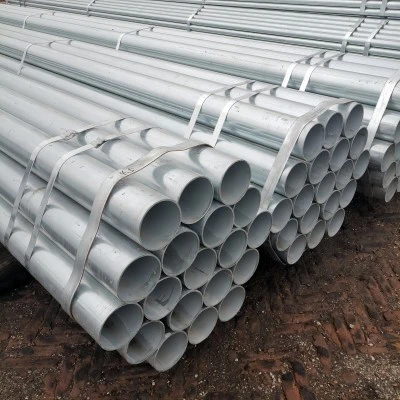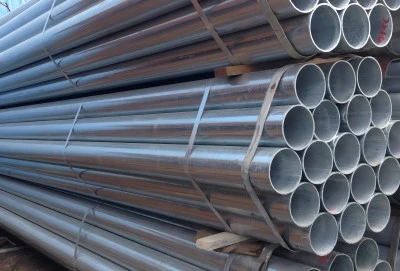In the ever-evolving world of sustainable construction, architects, engineers, and builders are constantly seeking innovative materials that combine durability, cost-effectiveness, and environmental responsibility. One such material that has gained significant traction in recent years is the galvanized mild steel pipe. This versatile product has become a cornerstone in sustainable building projects, offering a range of benefits that align perfectly with the principles of green construction.
At Hebei Longma Group Limited (LONGMA GROUP), we've been at the forefront of manufacturing high-quality steel pipes since 2003. Our commitment to sustainability and innovation has led us to recognize the immense potential of galvanized mild steel pipes in eco-friendly construction. In this article, we'll explore the various ways these pipes contribute to sustainable building practices and why they're becoming an increasingly popular choice among environmentally conscious professionals.
|
|
|
Eco-Friendly Benefits of Galvanized Mild Steel Pipes
Galvanized mild steel pipes offer a plethora of environmental advantages that make them an excellent choice for sustainable building projects. Let's delve into some of the key eco-friendly benefits:
Longevity and Durability
One of the most significant environmental benefits of galvanized steel pipes is their exceptional longevity. The galvanization process, which involves coating the steel with a protective layer of zinc, dramatically enhances the pipe's resistance to corrosion and rust. This increased durability translates to a longer lifespan, reducing the need for frequent replacements and, consequently, minimizing waste and resource consumption.
In fact, galvanized steel pipes can last up to 50 years or more with proper maintenance, making them a sustainable choice for long-term building projects. This extended lifespan not only reduces the environmental impact associated with manufacturing and transporting replacement materials but also contributes to the overall sustainability of the structure.
Recyclability
Another crucial eco-friendly aspect of galvanized mild steel pipes is their high recyclability. Steel is one of the most recycled materials in the world, and galvanized steel is no exception. At the end of their useful life, these pipes can be fully recycled without losing their inherent properties, creating a closed-loop system that minimizes waste and conserves natural resources.
The recycling process for galvanized steel is energy-efficient compared to producing new steel from raw materials. This energy savings contributes to reduced carbon emissions and a smaller overall environmental footprint. By choosing galvanized mild steel pipes, builders are effectively supporting a more sustainable and circular economy in the construction industry.
Low Embodied Energy
Embodied energy refers to the total energy consumed in the production, transportation, and installation of a material. Galvanized mild steel pipes have a relatively low embodied energy compared to many alternative materials used in construction. This is due to the efficiency of modern steel production methods and the fact that galvanization is a relatively simple and low-energy process.
The low embodied energy of galvanized steel pipes means that their production and use contribute less to overall carbon emissions and energy consumption in the building sector. This makes them an attractive option for projects aiming to minimize their carbon footprint and achieve sustainability certifications.
How Galvanized Steel Contributes to Green Building Practices
Galvanized mild steel pipes play a crucial role in advancing green building practices. Their unique properties and versatility make them an ideal choice for sustainable construction projects. Let's explore how these pipes contribute to various aspects of green building:
Energy Efficiency
Energy efficiency is a cornerstone of green building, and galvanized steel pipes can significantly contribute to this goal. When used in plumbing and HVAC systems, these pipes offer excellent thermal conductivity, which can enhance the overall energy efficiency of a building. This property allows for more effective heat transfer in heating and cooling systems, potentially reducing energy consumption and associated costs.
Moreover, the smooth interior surface of galvanized pipes reduces friction, allowing for more efficient fluid flow. This can lead to reduced pumping energy requirements in water distribution systems, further contributing to the building's energy efficiency.
Water Conservation
Water conservation is another critical aspect of sustainable building practices, and galvanized mild steel pipes excel in this area. Their corrosion resistance and durability make them ideal for water distribution systems, reducing the risk of leaks and water waste over time. The zinc coating also prevents the buildup of rust and scale inside the pipes, maintaining consistent water flow and quality.
In addition, the use of galvanized steel pipes in rainwater harvesting systems can contribute to water conservation efforts. These pipes can efficiently collect and distribute rainwater for non-potable uses, reducing reliance on municipal water supplies and promoting sustainable water management practices.
Indoor Environmental Quality
The use of galvanized steel pipes can positively impact indoor environmental quality, an essential consideration in green building design. Unlike some plastic piping materials, galvanized steel does not off-gas harmful chemicals or volatile organic compounds (VOCs) that can negatively affect indoor air quality. This makes them a safer choice for occupants, particularly in residential and commercial buildings where air quality is paramount.
Furthermore, the corrosion resistance of galvanized pipes helps prevent the leaching of contaminants into water systems, ensuring cleaner and safer water supply within buildings. This is particularly important in areas where water quality may be a concern, as it helps maintain the health and well-being of building occupants.
Structural Integrity and Safety
Galvanized mild steel pipes contribute to the structural integrity and safety of buildings, which are crucial aspects of sustainable construction. Their high strength-to-weight ratio makes them ideal for various structural applications, from support columns to railings and framing. This strength allows for more efficient use of materials, potentially reducing the overall material consumption in construction projects.
The fire-resistant properties of galvanized steel also enhance building safety. In the event of a fire, these pipes maintain their structural integrity for longer periods compared to many alternative materials, potentially providing crucial time for evacuation and firefighting efforts. This improved fire safety contributes to the overall sustainability of the building by reducing the risk of catastrophic damage and the need for extensive repairs or reconstruction.
Reducing Environmental Impact with Galvanized Steel Pipes
The use of galvanized mild steel pipes in construction projects can significantly reduce environmental impact in various ways. Let's explore how these versatile pipes contribute to a more sustainable building industry:
Minimizing Resource Depletion
One of the most significant ways galvanized steel pipes help reduce environmental impact is by minimizing resource depletion. The longevity of these pipes means that they need to be replaced less frequently than many alternative materials. This reduced need for replacement translates directly into lower demand for raw materials and energy required for manufacturing new pipes.
Moreover, the high recyclability of galvanized steel further contributes to resource conservation. When these pipes eventually reach the end of their useful life, they can be fully recycled and used to create new steel products. This circular approach to material use helps conserve natural resources and reduces the environmental impact associated with mining and processing raw materials.
Reducing Carbon Footprint
The production and use of galvanized mild steel pipes can contribute to reducing the overall carbon footprint of construction projects. While the initial production of steel does involve significant energy use, the long lifespan of galvanized pipes means that this energy investment is spread out over many years of use. When compared to materials that require frequent replacement, the long-term carbon footprint of galvanized steel pipes is often lower.
Additionally, the recyclability of these pipes further reduces their carbon impact. Recycling steel requires significantly less energy than producing new steel from raw materials, resulting in lower carbon emissions. By choosing galvanized steel pipes, builders are effectively supporting a more carbon-efficient material cycle in the construction industry.
Minimizing Waste Generation
Waste reduction is a crucial aspect of sustainable construction, and galvanized steel pipes excel in this area. Their durability and resistance to corrosion mean that they generate less waste over time compared to materials that degrade more quickly. This reduced waste generation not only helps minimize the environmental impact of construction projects but also reduces the costs and environmental burdens associated with waste disposal.
Furthermore, when galvanized steel pipes do reach the end of their useful life, they can be recycled without generating significant waste. This is in stark contrast to many plastic or composite materials, which often end up in landfills due to difficulties in recycling. The ability to fully recycle galvanized steel pipes contributes to a more circular and waste-efficient construction industry.
Improving Water Quality
The use of galvanized steel pipes can also contribute to improved water quality, which has both environmental and health benefits. The corrosion resistance of these pipes helps prevent the leaching of metals and other contaminants into water systems. This is particularly important in areas where water quality may be a concern, as it helps protect both human health and aquatic ecosystems.
Moreover, the smooth interior surface of galvanized pipes resists the buildup of biofilms and scale, which can harbor harmful bacteria and reduce water quality over time. This characteristic helps maintain consistent water quality throughout the lifespan of the pipes, reducing the need for chemical treatments and potential environmental contamination.
Supporting Sustainable Urban Development
As urbanization continues to accelerate globally, the role of sustainable building materials becomes increasingly crucial. Galvanized mild steel pipes support sustainable urban development in several ways. Their durability and low maintenance requirements make them ideal for urban infrastructure projects, where minimizing disruptions due to repairs and replacements is essential.
Additionally, the versatility of these pipes allows for innovative design solutions that can contribute to more compact and efficient urban spaces. From vertical gardens to modular construction techniques, galvanized steel pipes enable architects and engineers to create sustainable urban environments that maximize space utilization while minimizing environmental impact.
Enhancing Building Resilience
In the face of climate change and increasing extreme weather events, building resilience has become a critical aspect of sustainable construction. Galvanized mild steel pipes contribute to building resilience in several ways. Their corrosion resistance makes them suitable for use in challenging environments, including coastal areas exposed to salt spray or regions with high humidity.
The strength and durability of these pipes also make them resistant to damage from seismic activities, high winds, and other natural disasters. This enhanced resilience means that buildings constructed with galvanized steel pipes are less likely to require extensive repairs or reconstruction after extreme events, reducing the long-term environmental impact and resource consumption associated with building maintenance and reconstruction.
In conclusion, the role of galvanized mild steel pipes in sustainable building projects is multifaceted and significant. From their eco-friendly benefits and contributions to green building practices to their ability to reduce environmental impact, these versatile pipes are proving to be an invaluable asset in the quest for more sustainable construction methods.
At Hebei Longma Group Limited (LONGMA GROUP), we're committed to providing high-quality galvanized steel pipes that meet the evolving needs of the sustainable construction industry. Our products are designed to offer the durability, efficiency, and environmental benefits that modern building projects demand.
If you're interested in learning more about how our galvanized mild steel pipes can contribute to your sustainable building project, we invite you to get in touch with our team of experts. Contact us at info@longma-group.com to discuss your specific requirements and discover how we can help you achieve your sustainability goals.














